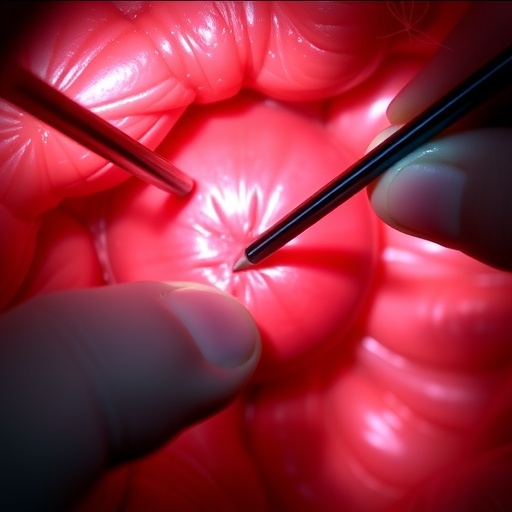In an era where technological advancements are revolutionizing the medical field, the approach to living donor nephrectomy, the surgical removal of a kidney from a living donor, is also undergoing significant transformation. Researchers have recently published a comprehensive study detailing non-invasive methods for performing this critical procedure, emphasizing the importance of minimizing risks while optimizing outcomes for both donors and recipients. As the need for kidney transplants continues to rise, innovative practices in nephrectomy are more crucial than ever, ensuring that the supply of viable organs meets the increasing demand.
The traditional method of kidney removal has long involved significant surgical intervention, which inherently poses risks such as extended recovery times, complications related to anesthesia, and increased potential for post-operative pain for the donor. The surgical community is thus incentivized to explore alternatives that reduce the physical toll on individuals volunteering to donate their kidneys. This study illustrates how advancements in surgical techniques and medical technology contribute to a paradigm shift in how nephrectomies can be performed.
One of the most compelling aspects of non-invasive approaches lies in their ability to reduce trauma to the body. Rather than large incisions, minimally invasive techniques, including laparoscopic and robotic-assisted surgeries, offer a way to procure kidneys through smaller openings. These methods leverage modern imaging technologies to guide surgeons with enhanced precision, significantly diminishing the potential for complications. As a result, these techniques align seamlessly with the overarching goal of patient-centered care, ensuring that living donors experience less pain and a quicker recovery while contributing to life-saving initiatives.
Furthermore, the integration of technological innovations such as virtual reality (VR) and augmented reality (AR) into surgical training is another noteworthy development in the landscape of nephrectomy. Surgeons can practice complex procedures in a risk-free environment, allowing them to refine their skills before operating on actual patients. The immersive experiences offered by VR can help in visualizing anatomical complications and planning surgical approaches, thus enhancing overall surgical efficacy.
On the research front, experts are heavily investing in biomaterial studies aimed at optimizing post-operative recovery. By exploring the properties of various materials and their interactions with biological systems, researchers are uncovering ways to improve healing times and reduce inflammation in donors. This pursuit plays a crucial role in ensuring overall donor health and well-being in the aftermath of kidney donation, thereby encouraging more individuals to consider becoming living donors.
In addition to the surgical and technological advancements, this comprehensive study also emphasizes the significance of psychological and emotional well-being in the living donation process. There is a growing recognition that donor candidates should not only be evaluated physically but also psychologically. Establishing a support system and providing counseling can help alleviate anxiety and ensure that donors fully understand the implications of their decision. This holistic approach fosters an environment where individuals feel valued and supported throughout the donation process.
The socio-economic factors influencing living donor rates cannot be overlooked. In many communities, awareness, education, and access to kidney donation programs are pivotal to increasing the living donor pool. The integration of community outreach initiatives that educate potential donors about the benefits and safety of living kidney donation is crucial. Equipping people with knowledge can demystify the process, encourage individuals to come forward, and ultimately transform public perception about the act of donating a kidney.
As the research community continues to push boundaries, collaborations between interdisciplinary teams become increasingly vital. Surgeons, researchers, ethicists, and counselors must work synergistically to create a seamless donor experience that prioritizes safety and satisfaction. This cooperative approach fosters innovation and leads to the development of best practices that can be shared and adopted across medical institutions.
The ultimate goal remains the same: to enhance kidney transplant outcomes while safeguarding the lives of living donors. By embracing non-invasive techniques, coupled with robust support and educational outreach, the surgical realm is witnessing transformative advancements that not only promise improvements in clinical practice but also advocate for the moral imperatives of donor safety and well-being.
As we celebrate these innovations in living donor nephrectomy, it is equally critical to acknowledge the ongoing challenges. While the advancements pave the way for a brighter future, continuous evaluation and refinement of these practices are needed to meet evolving healthcare standards and patient expectations. As science progresses, so too must we ensure that ethical considerations are prioritized, and that all potential living donors are provided trustworthy information and comprehensive care.
In conclusion, the transition toward non-invasive nephrectomy techniques represents a significant leap forward in the world of organ transplantation. This not only reflects technical advancements but also a broader commitment to enhancing the lives of those who selflessly choose to donate a part of themselves for the benefit of others. The ongoing dialogue among researchers and clinicians, coupled with a dedication to patient-centric methodologies, will undoubtedly lead to further innovations that transform the landscape of living donor nephrectomies and organ transplantation as a whole.
The continual evolution in surgical methods underscores the importance of adaptive solutions that prioritize donor health and recipient outcomes. The knowledge shared through this research not only has the potential to save lives but also may inspire further inquiry into optimizing living donation processes for decades to come. As the medical community looks towards the future, the commitment to maintaining excellent standards of care will remain pivotal in this evolving field.
Subject of Research: Non-Invasive Approaches to Living Donor Nephrectomy
Article Title: Non-Invasive Approaches To Living Donor Nephrectomy: Best Practices and Innovations
Article References:
Patel, R., Fleetwood, V.A., Bhusal, S. et al. Non-Invasive Approaches To Living Donor Nephrectomy: Best Practices and Innovations.
Curr Transpl Rep 12, 38 (2025). https://doi.org/10.1007/s40472-025-00487-3
Image Credits: AI Generated
DOI: 10.1007/s40472-025-00487-3
Keywords: Living donor nephrectomy, non-invasive techniques, surgical innovations, kidney transplantation, donor safety.




